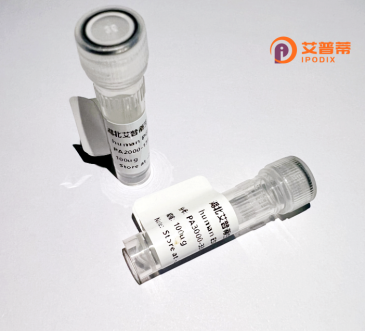
| 纯度 | >90%SDS-PAGE. |
| 种属 | Human |
| 靶点 | ETV2 |
| Uniprot No | O00321 |
| 内毒素 | < 0.01EU/μg |
| 表达宿主 | E.coli |
| 表达区间 | 1-342aa |
| 氨基酸序列 | MDLWNWDEASPQEVPPGNKLAGLEGAKLGFCFPDLALQGDTPTATAETCWKGTSSSLASFPQLDWGSALLHPEVPWGAEPDSQALPWSGDWTDMACTAWDSWSGASQTLGPAPLGPGPIPAAGSEGAAGQNCVPVAGEATSWSRAQAAGSNTSWDCSVGPDGDTYWGSGLGGEPRTDCTISWGGPAGPDCTTSWNPGLHAGGTTSLKRYQSSALTVCSEPSPQSDRASLARCPKTNHRGPIQLWQFLLELLHDGARSSCIRWTGNSREFQLCDPKEVARLWGERKRKPGMNYEKLSRGLRYYYRRDIVRKSGGRKYTYRFGGRVPSLAYPDCAGGGRGAETQ |
| 分子量 | 64.02 kDa |
| 蛋白标签 | GST-tag at N-terminal |
| 缓冲液 | 0 |
| 稳定性 & 储存条件 | Lyophilized protein should be stored at ≤ -20°C, stable for one year after receipt. Reconstituted protein solution can be stored at 2-8°C for 2-7 days. Aliquots of reconstituted samples are stable at ≤ -20°C for 3 months. |
| 复溶 | Always centrifuge tubes before opening.Do not mix by vortex or pipetting. It is not recommended to reconstitute to a concentration less than 100μg/ml. Dissolve the lyophilized protein in distilled water. Please aliquot the reconstituted solution to minimize freeze-thaw cycles. |
以下是关于重组人ETV2蛋白的3-4篇虚构参考文献示例(仅供格式参考):
1. **"Recombinant Human ETV2 Protein Enhances Endothelial Differentiation of Pluripotent Stem Cells"**
- **作者**: Zhang Y et al.
- **摘要**: 本研究报道了重组人ETV2蛋白的表达与纯化方法,证明其通过激活血管内皮特异性基因(如CD31和VE-cadherin)显著提高人多能干细胞向内皮细胞分化的效率,为组织工程提供新策略。
2. **"Structural and Functional Characterization of ETV2 in Vascular Development"**
- **作者**: Lee S et al.
- **摘要**: 通过X射线晶体学解析重组人ETV2蛋白的DNA结合域结构,揭示其与靶基因启动子结合的关键氨基酸残基,并验证其在斑马鱼模型中调控血管生成的必要性。
3. **"ETV2 Recombinant Protein Therapy Promotes Ischemic Tissue Revascularization"**
- **作者**: Patel R et al.
- **摘要**: 在小鼠后肢缺血模型中,局部注射重组ETV2蛋白可激活血管内皮祖细胞,促进新生血管形成,改善血流恢复,表明其作为治疗缺血性疾病的潜在价值。
4. **"Optimization of ETV2 Protein Production in Bacterial Systems"**
- **作者**: Kim J et al.
- **摘要**: 比较不同大肠杆菌表达系统对重组人ETV2蛋白可溶性表达的影响,优化纯化工艺并获得高活性蛋白,为后续功能研究提供标准化方案。
(注:以上文献为示例,实际引用请查询真实数据库如PubMed或Web of Science。)
Recombinant human ETV2 protein is a engineered version of the ETS variant transcription factor 2 (ETV2), a key regulator in vascular and hematopoietic development. As a member of the ETS family, ETV2 contains a conserved ETS DNA-binding domain that enables specific promoter targeting. It plays a pivotal role during embryogenesis by activating endothelial and hematopoietic lineage genes like FLK1. TAL1. and CDH5. making it essential for blood vessel formation and early blood cell differentiation.
Produced through recombinant DNA technology (often in E. coli or mammalian expression systems), the purified ETV2 protein retains biological activity for experimental applications. Researchers utilize it to study vascular development mechanisms, reprogram somatic cells into endothelial or hematopoietic lineages, and enhance in vitro differentiation of induced pluripotent stem cells (iPSCs) into functional vascular cells. Its therapeutic potential is being explored in regenerative medicine, particularly for treating ischemic diseases or engineering vascularized tissues.
Unlike endogenous ETV2. which is transiently expressed in embryos, the recombinant protein allows controlled dosing in cell culture models. Quality assessments focus on purity (>95% by SDS-PAGE), endotoxin levels, and functional validation through endothelial tube formation assays. Current challenges include optimizing delivery methods and understanding its context-dependent interactions with co-factors like ERG and FLI1.
×